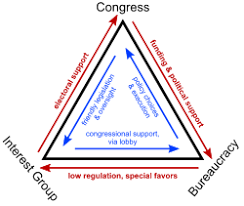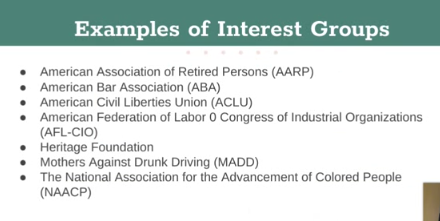Unit III - Interest Group Notes
What is an Iron Triangle?
^^The Iron Triangle consists of: Congress, interest groups, and the Bureaucracy.^^
The Iron Triangle has a bidirectional relationship; meaning that all three parties support each other. Basically give to get. One party is in need of the other two parties.
Factions cannot be rid of; but can be controlled by a diverse Republic.
note: the Iron Triangle is only a concept; not an institution.

What would James Madison call interest groups?
^^James Madison would call interest groups as factions.^^
Free Riders: people who benefit without contributing (in the instance of how beneficial interest groups are.
Rise of Interest Groups:
Early Beginnings: Sons of Liberty and the Federalists and Anti-Federalists.
**Economic:**Labor Unions and Farmers. \n
Policy: Changes to policy creates interest groups (like veterans).
**Social Action/Equality:**Desire for changes to social policy or access. \n
**Expanding Role of Government:**Created as the government’s role expands. \n
Public Interest: Work for the public’s best interest or the perception there of
Kinds of Interest Groups
^^interest groups: any group that seeks to influence public policy.^^
- main goals of an interest group are to raise money or votes to members of Congress to get elected so they can pass laws.
Institutional: Individuals/organizations that represent their organizations, companies, states, universities and foundations.
- example of a Institutional organization: Amazon.
Membership: Dependent on members joining and paying dues or donations.
- Membership interest groups are social, business, professional, veteran, charitable, and religious oriented.
- example of a Membership organization: National Rifle Association.

Lobbying; What is it?
Lobbying: Any communication “by someone other than a citizen acting on his or her own behalf, directed to a governmental decision maker with the hope of influencing his or her decision.” - Lester Milbrath.
- Lobbying is when someone is hired to go to the nation’s capital to influence the senator/house member assembly to take action on behalf of interest groups.
- organizations and interest groups hire lobbyist to influence the government at ALL levels.
- some influences can be good and some is bad.
Lobbyist are known for influencing lawmakers through information.
Why Join an Interest Group?
- builds political efficacy and civic duty.
- want to feel connected to their community.
- League of Women Voters, the NAACP, Rotary, and the American Legion build strong local organizations.
- some farm organizations give discounts for farm supplies to members.
- The American Association of Retired Person (AARP) offers low-cost life insurance and discounted prescription drugs, give advice, and group travel plans.
- Others join interests groups because they believe in the cause and see change happen. (example: environmental groups).
Interest Groups in Action
Supplying Information: Lobbyist provide credible information to Congress.
Raising Support: Grassroots mobilization to put pressure on Congress.
Creating PACS: used to funnel money to candidates that they favor.
Testifying for Congress: providing expert witness in committee hearing.
Socializing: attend and hold events in Washington D.C.
Endorsement: announce their support for specific candidate.
Propaganda: send our information to promote their views.
\n
Litigate: using the Supreme Court to decide on changes.
\n
^^Employing Former Government Officials: the “revolving door” means government officials go to work for interest groups.^^
\n
Protest/Disruption: public displays to gain awareness and bring about changes.
Political Action Committees (PACS)
What are PACS?
Political Action Committee (PAC): created by interest groups to fund candidates they agree with.
- PACS must be registered with the Federal Election Commission (FEC).
- Money given directly to the candidates campaign is hard money and is regulated closely.
- Money given to political parties is soft money; less restriction.
\n ^^PACS work for candidates and political parties by funneling money to them.^^
Super PACs
- ^^Super PACs are allowed to raise unlimited amounts of money and spend unlimited amounts of money^^ ^^advocating for or against a candidate. Unlike PACs, they are unable to give directly to candidates.^^
- created by Supreme Court cases.
- Citizens United v. FEC: Caps on amount of money a person can give to a PAC is unconstitutional and that corporations and unions could make unlimited donations (spending).
Regulation of Interest Groups - ERA 1
- Federal Election Campaign Act (FECA - 1970): Placed limits on individual contributions to candidates (hard money - limited and regulated) $1000 per candidate per election.
- no labor unions, corporations, or foreign nationals.
- Limited candidate spending.
- Disclosure laws - spending/raising - reported to the FEC (Federal Elections Commission).
- Hard money to candidates and soft money to political parties.
FECA Loopholes:
- Soft money goes to the parties.
- not limited or regulated.
- Bundling: money from individuals but given as a group.
- PACs - hard money ($5000 a year as it is 1st Amendment protected).
- Independent Expenditure Group (IEG).
- Citizens who come together but cannot be for a specific candidate or party.
Regulations - ERA 1
Buckley v. Valeo (1976)
- Upheld hard money limits.
- Struck down candidate spending limits - 1st Amendment - unless they accept public funding they are held to a spending limit.
- issue ads - soft money vs. expressed advocacy (“Vote for…”) - hard money.
Regulations - ERA 2 (2002 - 2010)
- Bipartisan Campaign Reform Act (McCain - Feingold) (BCRA) tried to remove unlimited funding.
- raised hard money limits: $5k to candidate $15k to party.
- banned soft money to parties.
- limited issue ads before elections.
- 30 days before a primary.
- 60 days before a general election. \n
BCRA Loopholes:
- IEGs explode
- 527 committees which are not regulated the same way.
- 501 (c4): Tax code - money spend as 51% to social welfare and 49% in political activities. (can hide any donator’s identity).
- does not have to disclose its donors.
Regulations - ERA 3 (2010 - present)
- Citizens United v. FEC; IEG funded by corporations, labor unions now protected by 1st Amendment.
Loopholes
- Super PACs can be a labor union or corporation.
- soft money
- independent of candidate
- 527 goes away but 501 (c4) is still active.
Which current court case made it easier for Super PACs to make an impact on elections? Citizens United v. FEC.
The government organization who is responsible for regulating campaign finances is known as Federal Election Campaign (FEC).
Main purpose of PACs is to get money directly and indirectly to candidates they agree with.